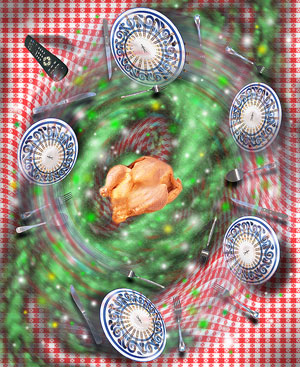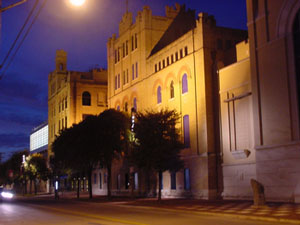This is the first in a series of articles exploring the museums of Texas, their unique characteristics, and the audiences they serve. Taken as a whole, the institutions throughout Texas house a huge number of works in collections that vary widely from one museum to the next. Our goal is to educate readers as to some of the highlights here in our own backyard.
This is the first in a series of articles exploring the museums of Texas, their unique characteristics, and the audiences they serve. Taken as a whole, the institutions throughout Texas house a huge number of works in collections that vary widely from one museum to the next. Our goal is to educate readers as to some of the highlights here in our own backyard.
According to Museum of Fine Arts, Houston Director Peter Marzio, regional museums generally have two options open to them regarding building their collections. One option is to achieve greater fame in the international community by specializing in more obscure or very specific areas. Local examples might be the Menil Collection’s specialty in Surrealism, or the Amon Carter’s focus on American (particularly Western) photography. The second option is to attempt to give a broader picture of art history by having a variety of key works — some antiquities, a few medieval relics, handfuls of works from the fifteenth through twentieth centuries, and so on — an approach which usually lacks the depth of a specialized collection, but which arguably does a better job of tackling the big picture. This encyclopedic approach is evidenced at the Museum of Fine Arts, Houston and the Dallas Museum of Art. Marzio believes both routes are valid ways to build a collection, so long as the institution’s objective is clear. In either case, all of the museums in Texas have as the foundation of their holdings the collections of local individuals, for better or for worse. Thus you have the San Antonio Museum of Art having an outstanding collection of antique Irish silver, for example, or the Fort Worth Modern’s rarely-seen original collection of relatively unremarkable early 20th century paintings — gifts from individuals who happened to collect in these areas, and who started the museums on their way.
We hope that this yearlong series will serve to shed light on the best of Texas museum collections, specialized or general as they may be. To kick the series off, we asked Catherine Walworth to spend some time with the rambling collection of the San Antonio Museum of Art.
Rachel Cook
December 2004
Encyclopedic museums, those that have cross-cultural collections like the San Antonio Museum of Art (SAMA), are often overwhelming in scope. But the feeling that there is always more to take in can also be euphoric. Recently I made three trips to SAMA in one week and realized that what I was writing was a travelogue.
First, the façade: The former Lone Star Brewery was built in 1884, and the Romanesque towers were added in 1904. Prohibition caused the closure of the brewery, and in 1921 it became the Lone Star Cotton Mills. The building continued to change hands and decay until 1970, when Jack MacGregor, then director of the San Antonio Museum Association, had designs on it as a personal residence. He decided instead that it could be an art museum, forged out of works from the Witte Museum (best known today for its natural history and anthropology holdings). And that, in short, is how the San Antonio Museum of Art was born.
While today museums build sleek, modern buildings by internationally famous architects, SAMA opened its doors in 1981 in the former brewery, nearly a century after it was built. Visitors are greeted by an open and spacious lobby. The Cowden gallery, towards the back of the lobby, is a 7,000 square foot space for traveling exhibitions. Apparently locals are pretty blasé about SAMA’s traveling exhibitions, which have recently included Hanten and Happi: Traditional Japanese Firemen’s Jackets and Work Coats, Tesoros Modernos: Latin American Masterpieces from the Monterrey FEMSA Collection, and currently, Visions of a Vanishing Culture: Edward S. Curtis and the North American Indian, all exhibitions that are potentially very interesting, even if they don’t have a huge draw. Even this summer’s Whitfield Lovell exhibition failed to cause much of a stir with the local art community. One exception, however, was last year’s Dale Chihuly exhibition Fire and Ice, which, as part of a multi-location celebration of his work, energized the general public and turned out record numbers of visitors.
Three marble, Greco-Roman sculptures, whose whiteness in the natural light is striking, stand on the lobby’s fringes. A label next to a sculpture of Emperor Trajan informs visitors that the Classical Art of Ancient Greece and Rome installations are temporarily closed due to the expansion of SAMA’s Asian Art galleries. The Ewing Halsell Wing in the San Antonio Museum of Art claims to have the most comprehensive collections of Ancient Egyptian, Greek, and Roman art in the Southern United States, although it is currently closed. In the meantime, curators have inserted classical Greek and Roman works throughout the museum’s other galleries, calling these “Classical Connections.” The idea has the potential to demonstrate how the Classical canon haunts so much of art history. Unfortunately, the end result is a bit limited — a goddess torso in the Near Eastern galleries is there merely to point out that the two cultures share the same mythical character.
Luckily, the Ancient Egyptian galleries remain open. It is amazing how this art holds such a romantic sense of the supernatural for visitors. While I was there a teenage girl shrieked, “I can’t believe I’m breathing Egyptian air!” I myself experienced different realizations that day. The installation emphasizes the sexiness of Egyptian art, punctuated but not limited to the ancient kohl sticks and mirrors. It’s in the surfaces and forms — the subtle, feline grace of stone sculptures and elegantly incised human profiles on reliefs. Alabaster headrests and Canopic jars remind that Minimalism has been around a really, really long time. Buoyancy of scale, too, is physically tangible between works in the gallery. A large, seated sculpture of the lion-headed goddess Sekhmet is flanked by cases of sculptures that would fit in the palm of your hand. Scale is more than a measurement in Egyptian art — it’s a concept. Artists had a system for honoring a person’s importance through scale. The smaller the figure in a painting or relief, the farther down on the social scale is the individual.

John Singer Sargent... Portrait of Mrs. Elliot Fitch Shepard, 1888... Oil on canvas, 84 x 48 inches...
From Egypt, you can take SAMA’s rather disco glass elevator upstairs to the Oceanic Art galleries, which were built in 2000. Maps and informative labels guides you through the native cultures of Australia, Hawaii, New Guinea, Malaysia, Micronesia, and Polynesia. A carved orator’s pulpit, or teket, from Papua New Guinea was used in community discussions. Speakers emphasized their important points by striking the pulpit with bunches of cordyline leaves, or by laying single leaves on the pulpit at key moments. Decadently large Hawaiian bowls made of wood took months to create. When cracks occurred, they were lovingly patched with butterfly joints and wedges and the bowls’ imperfections made them even more highly prized. Clubs, shields, and other handmade objects of war remind the viewer that war used to be fought close up, by fewer individuals in closer contact. The struggles were more epic for their very personal nature. This changes quickly, however, as spears, arrows, and later, bullets and bombs increased the distance between contenders.
These wood-heavy galleries flow into Near Eastern art galleries where materials morph into ceramic, bronze, textile, and manuscript pages. Babylonian, Assyrian, and Iranian cylinder seals are decorated with incredibly minute scenes of winged creatures, archers, and boar hunts. The potter’s wheel was invented in the Near East around 3500 B.C., and the ceramics on view span millennia. Islamic text flows like liquid smoke across various surfaces. Painted tiles with vines and flowers are stunning, but are mere pixels taken from the entire walls that once emphasized the importance of repetition and totality.
From here, you can cross over to the other side of the museum by way of the glass sky bridge with a lovely view of the city, and arrive in Europe. These European galleries are an abrupt change from the previous galleries, and the oil paintings and silver seem almost greasy and fussy in comparison with the antiquities. It’s hard to be bowled over by the small group of 18th and 19th century paintings — clearly not one of the museum’s strengths. One standout is Banquet Still Life by Dutch artist Abraham van Beyeren, a customary presentation of luxury items in contrast with soon-to-be rotting food, and a watch nearby that reminds us that nobody’s getting out of here alive.

Rolando Briseño (American, born 1952)... Black Hole, 2000... Giclee inkjet print... Gift of Rafael Guerra and Sandra Castro-Guerra...
Descending into the 18th and 19th American Art gallery is a jolt from fussy intellectual symbols to the hard-and-fast realities of pioneers and survivalists. Landscapes with moose, trail riders, fishing scenes, and Native Americans illustrate the world of manifest destiny. Satisfy your sweet tooth here with John Singer Sargent’s opulent Portrait of Mrs. Elliot Fitch Shepard in a corner of the room. Sargent gave her a magnificent red dress and a pale fur rug to tickle her feet with unconstrained gestural strokes. The painting’s quality contrasts with the wooden Quaker portraits nearby, and complements the few choice Art Nouveau pieces.
Modern and Contemporary Western art at SAMA is a disappointment in comparison with the museum’s larger collections. There are big names in these galleries — Hans Hoffman, Frank Stella, Helen Frankenthaler, Wayne Thiebaud, and Philip Guston — but overall, the examples are second or third rate and the hanging rarely changes. The Margaret and Robert Willson Gallery of Contemporary Art houses works largely chosen and donated by Linda Pace and ArtPace. This gallery is overwhelmingly devoted to local artists — strong pieces by Hills Snyder and Ken Little stand out amongst some rather lifeless oversized paintings. In the center of the room is one of the better “Classical Connections.” A Roman 1st century A.D. marble torso of Diana perches on its one remaining leg as her tunic’s folds produce repeating shadows. Next to this stands a Marilyn Lanfear sculpture that also captures soft folds in steadfast material — this time a huipil, a blouse-like garment worn by Mayan Indian women in Guatemala, cast in bronze and shored up by a single pole. There is a sense of billowing movement in both of pieces that transcends material. Jesse Amado’s piece Cry is better than its title. Buttery colored latex sags gently in places and a rust colored, oily stain bisects it like a Barnett Newman zip painting. Three sizable, glass droplets pierce and hang from the material. The result is ironically elegant in its resemblance to sweating fat.
While Western Contemporary art struggles along at SAMA, Latin Contemporary Art fairly shines. Examples by Diego Rivera, Joaquín Torres-García, and others are actually better than those in traveling shows such as Monterrey’s FEMSA Collection last year. Check out contemporary artist Enrique Chagoya’s modern take on screen-folded codices, The Adventures of the Modernist Cannibals, and then go downstairs and see facsimiles of two ancient codices in the extensive pre-Columbian Art galleries.
Since 1998, when SAMA acquired works from the Nelson A. Rockefeller Center for Latin American Art and built a 30,000-square foot wing to house the collection, the quality and range of Latin American art here has been world class. The various branches of the collection could easily take a day to visit all on their own. The viewer can realize a lot about the spread of influences on Latin American art — for example, the hybrid art forms in the Folk Art and Spanish Colonial and Republican Art galleries — while seeing examples of ancient art, to which native artists like Chagoya constantly return. The next branch of SAMA to receive such attention will be on the other side of the skywalk from Latin American Art. The current 6,000 square feet of Asian art galleries is the largest collection of its kind in Texas. This will expand to 15,000 square feet by May 2005, making it the largest in the Southwest. The new galleries will be dedicated as the Lenora and Walter F. Brown Asian Art Wing.
There is a wall label in the lobby where you can read about the new center for Asian Art and how it will enhance the museum’s mission to collect art that shows significant human achievement throughout time and place. Another statement says the museum’s goal is “to contribute a better quality of life for San Antonio and the state of Texas by offering this unique cultural resource and facility to enhance the understanding of Asian art and culture.” It will be interesting to see how the public responds to the expanded collection. People love what they know, and in the Pacific Northwest, where there are large populations of Asian Americans, Asian art infiltrates the culture. In Texas, Latin American art holds pride of place, and rightfully so. It certainly won’t hurt that a Toyota plant is slated to open soon in San Antonio. Regardless, the new addition will provide an important center for the study of Asian art and prolong the feeling that you’ve never seen everything there is at SAMA.
Images courtesy the San Antonio Museum of Art.
Catherine Walworth is a writer living in San Antonio.





